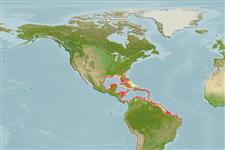Common names from other countries
Environment: milieu / climate zone / depth range / distribution range
Ecologia
marinhas associadas(os) a recifes; intervalo de profundidade 3 - 50 m (Ref. 9626). Subtropical; 34°N - 12°S, 99°W - 32°W
Western Atlantic: Bermuda, southeastern Florida (USA), and the Bahamas to Brazil.
Comprimento de primeira maturação / Tamanho / Peso / Idade
Maturity: Lm 19.0 range ? - ? cm
Max length : 33.0 cm TL macho/indeterminado; (Ref. 7251); common length : 25.0 cm TL macho/indeterminado; (Ref. 3798); peso máx. publicado: 550.00 g (Ref. 5217)
Espinhos dorsais (total) : 12; Raios dorsais (total) : 15 - 17; Raios anais : 8. Broad black area above line from dorsal fin origin to tip of lower caudal fin lobe, including upper part of caudal peduncle and both lobes of tail. Striking colored species, with a silvery body, black back and tail (Ref. 26938). With narrow yellow stripes, the broadest mid-lateral (Ref. 13442).
Inhabits clear inshore and offshore reefs (Ref. 9710) and adjacent grass beds, often in schools (Ref. 3798). Feeds on crustaceans (Ref. 3798). Marketed fresh (Ref. 3798).
Ciclo de vida ou comportamento de acasalamento
Maturities | Reprodução | Spawnings | Egg(s) | Fecundities | Larvas
Oviparous, distinct pairing during breeding (Ref. 205).
Robins, C.R. and G.C. Ray, 1986. A field guide to Atlantic coast fishes of North America. Houghton Mifflin Company, Boston, U.S.A. 354 p. (Ref. 7251)
Status na Lista Vermelha da UICN (Ref. 130435)
Can't connect to MySQL database (fbapp). Errorcode: Too many connections
